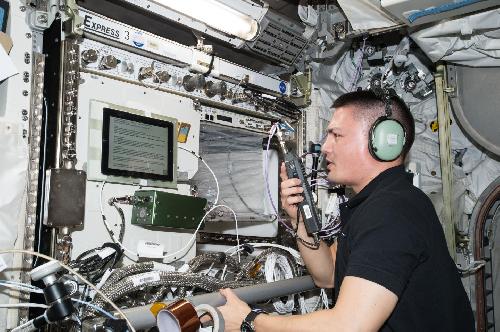On Thursday, March 10, 2016 astronauts on the International Space Station logged their 1,000th educational contact with the ground. NASA astronaut Tim Kopra answered questions posed by the North Dakota Space Grant Consortium in Grand Forks, North Dakota. No matter how many times it happens, talking directly with someone orbiting above the Earth remains a thrill for students.
Amateur Radio on the International Space Station (ARISS) works through an international consortium of amateur radio organizations and space agencies in the United States, Russia, Canada, Japan and Europe. Amateur, or ham, radio operators set up hardware on the ground and call NA1SS, the space station's radio call sign. The suspense is palpable as those on the ground await a reply from space.
A few students prepare and ask questions while hundreds of others, along with teachers, parents and members of the community, listen in from classrooms or auditoriums. The overall goal of this long-running experiment is to interest young people in mathematics and science, and inspire the next generation of explorers.
 NASA astronaut Kjell Lindgren participates in an amateur radio call with students while aboard the International Space Station during Expedition 45. Credit: NASA
NASA astronaut Kjell Lindgren participates in an amateur radio call with students while aboard the International Space Station during Expedition 45. Credit: NASA
Crew members typically answer from 10 to 20 questions. These frequently touch on current research and life aboard the station, along with a wide variety of topics from emergencies, whether a human heart beats faster or slower in space, how food is stored on the station, whether astronauts ever get fresh fruit and vegetables, and what returning to Earth is like.
One participant from the 1,000th call asked Kopra what kind of experiments he was conducting on the space station.
"We have lots of different kinds of experiments," Kopra responded. "Many of our experiments have to do with the effect of zero gravity on the human body, because it can be hard on the body - our muscles, our bones and our eyes. We'd like to learn how to solve those problems so that we can stay healthy and go into deep space, perhaps go back to the Moon or Mars someday."
Another student asked what Kopra thought the future of amateur radio aboard the space station would be.
"Amateur radio is a great way for us to reach people on Earth, and try to share our experience when we can," Kopra said.
ARISS accepts student applications to connect with the station during specific proposal cycles in the U.S. and Europe, with an open application process in other regions. Schools partner with an Amateur Radio Club or a ham radio operator to provide and operate equipment while teachers commit to having their students study space- and communications-related topics, including how amateur radio works.
"Approved applications go on a waiting list with a proposed week for contact," explains Kenneth Ransom, ISS Ham radio project coordinator at NASA's Johnson Space Center. "About a month out from that week, we predict when the station will pass over to see what might work for the school. That list gets prioritized and sent to NASA planners who try to fit a pass into the crew schedule."
Fitting into the busy crew schedule can present a challenge. Setting up the antenna to receive and transmit radio signals also often proves challenging, and radio operators have braved snow storms and ice to do so.
But these efforts are worth it. Teachers report that talking with crew members in space inspires their students, and has launched many into space-related careers -- including neuroscience, chemistry, physics, astronomy and engineering. The events bring entire schools and communities together. Many schools start amateur radio clubs after their ham radio experience.
Astronauts enjoy the contact as well. NASA astronaut Sunita Williams participated in events while a crew member on Expedition 32 in 2012.
"I get choked up every time I read a report about a Ham radio contact," she said at the ISS R&D Conference in 2015. "You go through the questions and it sounds like only 10 kids, then you read a report about how many people were at that event and how much preparation and time the kids took. It is nice to know it makes such a huge impact."
The speed at which the space station travels typically offers a window of about 10 minutes for contact, according to Ransom. The set-up varies at every ground station and so do the events.
"We call it an experiment, and sometimes experiments don't go the way we want them to," Ransom says. "We have had some that didn't work, for a variety of reasons, some that were spectacular successes and some that were marginal successes."
These 1,000 radio contacts have involved students from across the U.S., as well as 52 other countries from every continent and even a few islands.
Anyone with an amateur radio can listen in on scheduled contacts. Crew members on the space station also sometimes make general radio calls and talk to ham operators around the world.
Many ham contacts end with the earth-bound moderators saying, "We have shared a moment of history," and for the moderator of the North Dakota call, it was especially significant. Ham operator Charlie Sufana choked back tears as he closed the event.
"I had the luck of the draw to be the control operator for ARISS contact number one back in December 21, 2000," Sufana said in an emotional sign-off. "And once again, the luck of the draw allowed me to be the mentor moderator for the 1,000th contact. Here's to the next 1,000."
source: NASA/Johnson Space Center